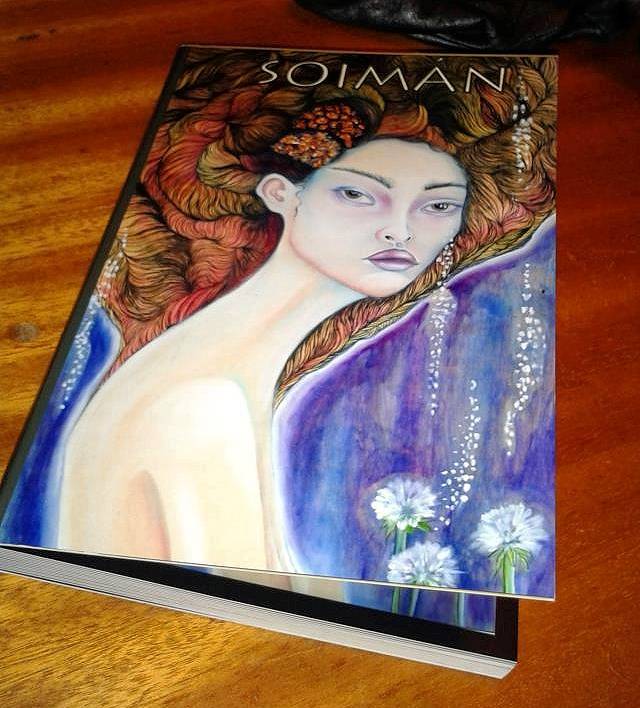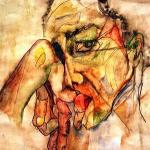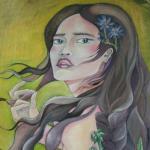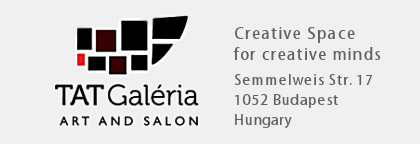Conversation with Regina Hunyadi (Soimán) - Fragile bodies, untamed souls
Soimán is a self-taught artist with a strong affection towards any sort of crafts besides painting and drawing. She started to paint at age fifteen but already by then she had gained practice in a variety of handicrafts, like knitting, crocheting, sewing and wood carving. She is also experimenting with mixed techniques, making illustrations and creating jewelry. Being able to process tough experiences through these activities provides her finally with calmness and inner peace. Concerning her paintings, she is mostly engaged in expressive portraits refined with a bit of Surrealism, usually composed into rather confined frameworks. Soimán's earliest paintings show a close relationship to Egon Schiele's works although she had not known this artist at that time yet. Even today the impact of the Viennese Art Nouveau can be recognized in her works.

![]() custos
You started to paint at age fifteen. What made you do this at that time?
custos
You started to paint at age fifteen. What made you do this at that time?
![]() Soimán
It was maybe a task at the art class that raised my interest. In those days I was interested in theatre but parallelly another affinity also took root/began to be formed in me. Painting had always fascinated me but I had never thought that I would be good in it or that I could express myself this way. My teacher commented on a self-portrait by me that I emulate Schiele in an outstanding way. This excited me to such an extent that I managed to quickly find out who he was, and, later, it was rather difficult to get rid of his direct stylistic impact.
Soimán
It was maybe a task at the art class that raised my interest. In those days I was interested in theatre but parallelly another affinity also took root/began to be formed in me. Painting had always fascinated me but I had never thought that I would be good in it or that I could express myself this way. My teacher commented on a self-portrait by me that I emulate Schiele in an outstanding way. This excited me to such an extent that I managed to quickly find out who he was, and, later, it was rather difficult to get rid of his direct stylistic impact.
![]() custos
Following your teacher's remark, have you started to get acquainted more systematically with Art Nouveau? In which ways do you think one artist can influence another with his style and oeuvre?
custos
Following your teacher's remark, have you started to get acquainted more systematically with Art Nouveau? In which ways do you think one artist can influence another with his style and oeuvre?
![]() Soimán
This is an extremely interesting and complicated question. Plenty of artists work under the "spell" of Art Nouveau, since it brings together all the experiences which are vital also for the societies of today. Beautism, refined lyricism, the ornaments and the cult of passing make an attractive combination; it is mystical and simple to interpret. Otherwise we always draw on each other and on preceding schools; what - or who - comes to the fore depends on with whom the artists can identify themselves the most, living through similar troubles of the society. We live in a stirred up, unceasingly changing world, resulting in frustration experienced by many of us. We were born into a world which is constantly losing from its sacrality, where our dreams and demands are defined by globalization, because consumer society can only be sustained if our attention is distracted from the essence towards irrevelant details. If our attention is being diverted and we rather concentrate on tiny things, becoming nervous without any definite reason, the viewpoint shifts, the world gets restricted and we lose our stability, floundering about the middle of chaos. This uncertainty leads towards narcissism in the arts. The trauma caused by globalization becomes visible in the close-up portraits and the lonely glances in my paintings. The figures are depicted in a virtual time and space. Details occur which cannot be directly connected to my closer cultural environment; ornaments are in an emphasized role, often nearly suffocating, absorbing the figures; or they only float in an undefined space, in Nothing.
Soimán
This is an extremely interesting and complicated question. Plenty of artists work under the "spell" of Art Nouveau, since it brings together all the experiences which are vital also for the societies of today. Beautism, refined lyricism, the ornaments and the cult of passing make an attractive combination; it is mystical and simple to interpret. Otherwise we always draw on each other and on preceding schools; what - or who - comes to the fore depends on with whom the artists can identify themselves the most, living through similar troubles of the society. We live in a stirred up, unceasingly changing world, resulting in frustration experienced by many of us. We were born into a world which is constantly losing from its sacrality, where our dreams and demands are defined by globalization, because consumer society can only be sustained if our attention is distracted from the essence towards irrevelant details. If our attention is being diverted and we rather concentrate on tiny things, becoming nervous without any definite reason, the viewpoint shifts, the world gets restricted and we lose our stability, floundering about the middle of chaos. This uncertainty leads towards narcissism in the arts. The trauma caused by globalization becomes visible in the close-up portraits and the lonely glances in my paintings. The figures are depicted in a virtual time and space. Details occur which cannot be directly connected to my closer cultural environment; ornaments are in an emphasized role, often nearly suffocating, absorbing the figures; or they only float in an undefined space, in Nothing.
![]() custos
When making some kind of handicraft, which are your favourite materials? Which is the field in which you can express your ideas the best besides painting?
custos
When making some kind of handicraft, which are your favourite materials? Which is the field in which you can express your ideas the best besides painting?
![]() Soimán
When I was still a child, my parents tought me lots of different handicraft techniques. I was a friendly, yet reserved kid, I preferred to be engaged in my own things to play hide-and-seek with the others, wherefore at age four I was already skilled in writing, reading and calculating, and at age seven I could embroider and crochet, knit sweaters with various patterns, make technical drawings beside my dad on his large drawing board; and I also carved wood, learned to play music - briefly, I had set about everything possible. My father is an exceptionally gifted person, and although our family is rather poor, my parents have always supported me in doing my "hobbies," thus I have never been short in anything and was able to unfold my creativity. Also nowadays I enjoy making jewelry and dresses. I would love to work with metal, to learn lathing, to make stage sets, and also to compile a foreign language learning and developing program for kids. For this latter I've been preparing myself for years now, collecting ideas and games, and making illustrations.
Soimán
When I was still a child, my parents tought me lots of different handicraft techniques. I was a friendly, yet reserved kid, I preferred to be engaged in my own things to play hide-and-seek with the others, wherefore at age four I was already skilled in writing, reading and calculating, and at age seven I could embroider and crochet, knit sweaters with various patterns, make technical drawings beside my dad on his large drawing board; and I also carved wood, learned to play music - briefly, I had set about everything possible. My father is an exceptionally gifted person, and although our family is rather poor, my parents have always supported me in doing my "hobbies," thus I have never been short in anything and was able to unfold my creativity. Also nowadays I enjoy making jewelry and dresses. I would love to work with metal, to learn lathing, to make stage sets, and also to compile a foreign language learning and developing program for kids. For this latter I've been preparing myself for years now, collecting ideas and games, and making illustrations.

![]() custos
Your figures in your paintings are always women. Why do you think you use women to express your ideas and feelings?
custos
Your figures in your paintings are always women. Why do you think you use women to express your ideas and feelings?
![]() Soimán
I would love to begin something else, too, but for the moment I try to approach the more sublime topics in an humble way. Until my technique cannot match such subjects I only collect and store these latter in my head. I love to paint female portraits which are slightly erotic and vulnerable but at the same time strong, too. For me this is the clearest way to tell stories. I wish the penetrating gaze of my figures could reveal personal tragedies and feelings. My own stories and their characters stay concealed - what I transmit is the feeling, the atmosphere of these events, the result of the absorbing and processing experiences and individual lots. That is why I paint faces. That is why I paint women. I tend to speak too much and painting portraits forces me to stay in a reasonable framework.
Soimán
I would love to begin something else, too, but for the moment I try to approach the more sublime topics in an humble way. Until my technique cannot match such subjects I only collect and store these latter in my head. I love to paint female portraits which are slightly erotic and vulnerable but at the same time strong, too. For me this is the clearest way to tell stories. I wish the penetrating gaze of my figures could reveal personal tragedies and feelings. My own stories and their characters stay concealed - what I transmit is the feeling, the atmosphere of these events, the result of the absorbing and processing experiences and individual lots. That is why I paint faces. That is why I paint women. I tend to speak too much and painting portraits forces me to stay in a reasonable framework.
![]() custos
Lots of symbolic details can be discovered in your paintings: the thick bunches of hair; the steady gazes; nudity; the rich vegetation and the ornaments. Do you paint them knowingly or spontaneously?
custos
Lots of symbolic details can be discovered in your paintings: the thick bunches of hair; the steady gazes; nudity; the rich vegetation and the ornaments. Do you paint them knowingly or spontaneously?
![]() Soimán
It is only half conscious - I also understand many details subsequently. I recognize symbolic elements stemming from deeply hidden sources which were not planned so but are rather conspicuous for experts. It may sound somewhat scary but, to be honest, I enjoy the analysis of an already finished painting. The four pieces of the series Bad mood came by themselves, without any plans, and I realized lots of motives later on. For example, I loved listening to folk music at that time and the lines "I thought it is raining but it is my eye weeping; a dense cloud is my eye, and rain lashes me pouring down" can be recognized in the last part of this series. The dandelions, the clouds and the laces all symbolize inner sobbing; the process of purification, chastity and at once dieing. The locks of hair coiling like a cotton ball or the convolution of the brain stand for the concealed inner chaos, since they are apparently well arranged around the face, expressing tidiness. Painting functions also as a therapy for me, thus while I restrain my imagination in composing my pieces, I let symbols flow and take the place they wish.
Soimán
It is only half conscious - I also understand many details subsequently. I recognize symbolic elements stemming from deeply hidden sources which were not planned so but are rather conspicuous for experts. It may sound somewhat scary but, to be honest, I enjoy the analysis of an already finished painting. The four pieces of the series Bad mood came by themselves, without any plans, and I realized lots of motives later on. For example, I loved listening to folk music at that time and the lines "I thought it is raining but it is my eye weeping; a dense cloud is my eye, and rain lashes me pouring down" can be recognized in the last part of this series. The dandelions, the clouds and the laces all symbolize inner sobbing; the process of purification, chastity and at once dieing. The locks of hair coiling like a cotton ball or the convolution of the brain stand for the concealed inner chaos, since they are apparently well arranged around the face, expressing tidiness. Painting functions also as a therapy for me, thus while I restrain my imagination in composing my pieces, I let symbols flow and take the place they wish.

![]() custos
What does painting mean for you, what is its role in your life? What happened if you were not able to paint for a while?
custos
What does painting mean for you, what is its role in your life? What happened if you were not able to paint for a while?
![]() Soimán
Any sort of creativity is a ritual activity, a remedy for myself, a sacred process, a kind of mediation. If things lose their sacred character and we cannot notice but their materiality, we bring also our own being down to a material level. Man had ordered a secondary meaning beside the elements of the surrounding world long ago, thus creating the symbols which indicated his way in life, in order to find his place in the world, keeping him close to nature. He set the world in order by developing a general system of symbols in which the essence of things melted into one. Thus he not only placed signals indicating the right path but could also find an answer to the questions tormentig his soul, since with the help of these symbols he could reach even his unconscious. When I paint, I do the same thing, making order in the chaos raging within me. I think I'm truly lucky for being able to take energy and remedy from myself. Once I grab the brush, a machine is being turned on, the stages of the illness follow each other: agony, standstill and, finally, recovery. If for any reason I was not enabled to continue painting, I could find an opportunity to be creative in another field. If I can grab my stirrer or the pruning shears I can still make use of my creativity, because cooking and gardening gives me equal happiness.
Soimán
Any sort of creativity is a ritual activity, a remedy for myself, a sacred process, a kind of mediation. If things lose their sacred character and we cannot notice but their materiality, we bring also our own being down to a material level. Man had ordered a secondary meaning beside the elements of the surrounding world long ago, thus creating the symbols which indicated his way in life, in order to find his place in the world, keeping him close to nature. He set the world in order by developing a general system of symbols in which the essence of things melted into one. Thus he not only placed signals indicating the right path but could also find an answer to the questions tormentig his soul, since with the help of these symbols he could reach even his unconscious. When I paint, I do the same thing, making order in the chaos raging within me. I think I'm truly lucky for being able to take energy and remedy from myself. Once I grab the brush, a machine is being turned on, the stages of the illness follow each other: agony, standstill and, finally, recovery. If for any reason I was not enabled to continue painting, I could find an opportunity to be creative in another field. If I can grab my stirrer or the pruning shears I can still make use of my creativity, because cooking and gardening gives me equal happiness.
![]() custos
Can your paintings speak for themselves or an analysis is needed? Do you think also here can exist several stories, another interpretation by each who looks at them?
custos
Can your paintings speak for themselves or an analysis is needed? Do you think also here can exist several stories, another interpretation by each who looks at them?
![]() Soimán
In the case of the more serious topics it is necessary to give at least some instructions to make their processing easier, but everyone should be allowed to interpret the painting in his or her own way, to be able to get involved. I love the relating passage from Zarathustra: "I am a railing alongside the torrent; whoever is able to grasp me may grasp me! Your crutch, however, I am not." Everyone has his or her own stories, several of them, even some which are not told but which are slumbering deep; they should be left alone to be able to recognize their own experiences in the image. Although I love to listen to the singing birds and try to focus on them, in my soul there play also more gloomy tunes... and strings also snap sometimes. This is why my works are so contrasting: from the gently touching I can get to brutal in one day; softly uniting brushstrokes are being replaced by abrupt and passionate lines, hard topics. Chimamanda Adichie, Nigerian writer has spoken a few years ago about story telling and the dangers of "a single story" in a lecture by her, indirectly calling attention to our biases, which allow us to notice only one story. This is how a "pigeonhole" is being created, and in a more serious case, even prejudices. Most of the people know me as a person who loves to surround herself with beautiful objects, who is cheerful and who lives in a world of fairy tales; but I also have more stories. Not only fables but also dramas, tragicomedies and thrillers make my life. It was Brian Eno who said "stop thinking about art works as objects, and start thinking about them as triggers for experiences." I hope I am able to convey these experiences in a way which can delight or cure other people, lull them into a dream world, or, to the contrary, shake them and wake them up.
Soimán
In the case of the more serious topics it is necessary to give at least some instructions to make their processing easier, but everyone should be allowed to interpret the painting in his or her own way, to be able to get involved. I love the relating passage from Zarathustra: "I am a railing alongside the torrent; whoever is able to grasp me may grasp me! Your crutch, however, I am not." Everyone has his or her own stories, several of them, even some which are not told but which are slumbering deep; they should be left alone to be able to recognize their own experiences in the image. Although I love to listen to the singing birds and try to focus on them, in my soul there play also more gloomy tunes... and strings also snap sometimes. This is why my works are so contrasting: from the gently touching I can get to brutal in one day; softly uniting brushstrokes are being replaced by abrupt and passionate lines, hard topics. Chimamanda Adichie, Nigerian writer has spoken a few years ago about story telling and the dangers of "a single story" in a lecture by her, indirectly calling attention to our biases, which allow us to notice only one story. This is how a "pigeonhole" is being created, and in a more serious case, even prejudices. Most of the people know me as a person who loves to surround herself with beautiful objects, who is cheerful and who lives in a world of fairy tales; but I also have more stories. Not only fables but also dramas, tragicomedies and thrillers make my life. It was Brian Eno who said "stop thinking about art works as objects, and start thinking about them as triggers for experiences." I hope I am able to convey these experiences in a way which can delight or cure other people, lull them into a dream world, or, to the contrary, shake them and wake them up.

![]() custos
What would you be the most glad about your paintings?
custos
What would you be the most glad about your paintings?
![]() Soimán
I wish that my paintings, just like me, could find their place in the world one day.
Soimán
I wish that my paintings, just like me, could find their place in the world one day.







Hozzászólások
Rizal Pramana 2013-10-15 07:43:57
really beautiful and deep.. great interview!